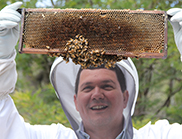Australia’s biosecurity may be shocked
These three events alone could devastate Australia’s agricultural industries, economy and environment, and could severely alter our way of life. But, how can we ensure that we see them coming and are we prepared to respond if they occur?
“If there was a significant decline in European honey bee populations across Australia in the future, for example, this would impact our economy with losses of around $4-6 billion.”
Dr Gary Fitt, CSIRO Biosecurity Flagship Science Director
As an island nation Australia has, largely been able to maintain an enviable biosecurity status. However, experts warn that the 12 biosecurity megashocks identified in a new report – Australia’s Biosecurity Future – could turn into reality if we become complacent with our nation’s biosecurity measures.
CSIRO Biosecurity Flagship Science Director Dr Gary Fitt said it was much better to pre-empt and avoid biosecurity issues than have to deal with the consequences.
“Dominating the news right now is the Ebola virus crisis, which is an obvious global health concern,” he said.
“Meanwhile farmers near Katherine, in the Northern Territory, are dealing with an outbreak of a new disease – Cucumber Green Mottle Mosaic Virus – and while not fatal to people like Ebola, this virus is devastating their crops which has severe financial impacts.”
The new report outlines a systematic examination and assessment of where we’re heading and what we need to do as a nation to protect our environment, industries, people and way of life over the next 20-30 years.
“If there was a significant decline in European honey bee populations across Australia in the future, for example, this would impact our economy with losses of around $4-6 billion,” Dr Fitt said. “Losing this free pollination service would severely impact production of several fruit and vegetables including avocados and almonds.”
In addition to considering the 12 potential megashocks, the report identifies a number of global megatrends that highlight significant change and the growing complexity relating to our nation’s biosecurity challenges.
“We have identified a number of important trends, such as the need to produce more food for a growing population while dealing with ongoing pressure on the key soil, water and biodiversity resources which sustain production,” Dr Fitt said.
“These trends will produce new challenges for all our plant and animal industries, our environment and human health.
“Understanding the biosecurity megatrends identified in the report will help Australia prepare for, and deal with the pests and diseases that threaten our farming sector, environment and people.”
These trends point towards a future where existing biosecurity processes and practices may not be sufficient to protect Australia.
“The management of biosecurity will require a step change towards smarter and more efficient strategies that are ideally ahead of the pace of change around the world,” Professor Kurt Zuelke, Director CSIRO Biosecurity Flagship and Australian Animal Health Laboratory, said. “Australia should not rely on its relatively fortunate history and become complacent in the face of growing biosecurity challenges.”
“Minimising and managing risks while taking advantage of the opportunities that a successful biosecurity system presents will only be possible through a coordinated approach involving government, industry, scientists and the general public – a shared responsibility.”
CSIRO partnered with Animal Health Australia, the Plant Biosecurity Cooperative Research Centre (CRC) and the Invasive Animals CRC and consulted with various industry, government and scientific organisations to deliver the report – Australia’s Biosecurity Future. An initiative that is striving for a biosecurity system that is pre-emptive, responsive, resilient, and based on cutting edge surveillance, informatics and new technologies.
Read the full report – Australia’s Biosecurity Future.
Media resources
Click image for high resolution version
Additional images
- High resolution images available via Dropbox


